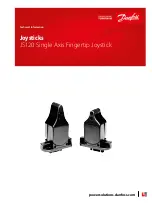
Curtis PMC 1209B/1221B/1221C/1231C Manual
24
MAINTENANCE & ADJUSTMENT
4
☞
C A U T I O N
MAINTENANCE & ADJUSTMENT
Curtis PMC 1209B/1221B/1221C/1231C controllers and potboxes require
only minimal maintenance if properly installed.
NOTE
: The controllers are sealed
and thus are not
fi
eld serviceable.
CONTROLLER
Maintenance
It is recommended that the following two steps be performed occasionally.
First
remove power by disconnecting the battery, and discharge the capacitors in
the controller
(with a light bulb or a 2
–
10
Ω
, 25 W resistor connected for a few
seconds across B+, B-). Follow good safety practices: get the vehicle drive wheels
off the ground, wear safety glasses, and use insulated tools
(see page 2)
.
1. Make sure the electrical connections to the controller (and to the motor,
contactors, etc.) are tight. When checking the controller bus bar connec-
tions for tightness, use two opposing wrenches. This double-wrench
technique will help avoid putting stress on the bus bars, which could
crack the seals.
Always use insulated wrenches.
2. Inspect all seals at the front and back of the controller. If necessary, use
a moist rag to wipe these areas clean enough so that you can see the seals.
Look for cracks and other signs of seal damage.
If the seals are intact, clean the controller thoroughly either by
washing it off or by wiping it clean with a moist rag.
Power must not be
reapplied until the controller terminal area is completely dry.
If the seals have been damaged, there are several possible causes.
Perhaps the double-wrench technique was not used when the cables were
installed. Perhaps the vehicle
’
s environment requires that the controller
be better protected: either by mounting it in a different location, or by
installing a protective cover.
Damaged seals can lead to faulty operation.
We strongly recom-
mend replacing controllers that have faulty seals.
Adjustment
Some controllers allow adjustment of the plug braking current, current limit, and
acceleration rate settings. The adjustment pots on these models are located as
shown in Figure 17.
















































